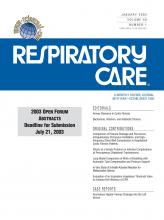Abstract
OBJECTIVE: Assess a prototype inspiratory impedance threshold valve (ITV) designed to enhance vital organ circulation during standard and active compression/decompression cardiopulmonary resuscitation (CPR).
BACKGROUND: The ITV attaches to commonly used airway assist devices and decreases intrathoracic pressure during the decompression (chest recoil) phase of CPR by creating a vacuum within the thorax, which increases venous blood flow to the heart and thus increases coronary perfusion pressure and blood flow to the brain.
METHODS: The evaluation included laboratory bench testing, according to American Society for Testing and Materials (ASTM) and International Standards Organization (ISO) guidelines, and performance testing with pigs in cardiac arrest. A vacuum pull test was developed to determine the inspiratory impedance under various inspiratory flow conditions.
RESULTS: The valve passed all minimum ASTM and ISO performance tests. During cardiac arrest in pigs the ITV decreased intrathoracic pressures by 6–8 mm Hg during the decompression phase. The vacuum pull test demonstrated that the prototype ITV functioned as intended.
CONCLUSIONS: The prototype ITV passed all performance testing recommended by international guidelines and functioned effectively as intended for use. The animal study results, when combined with recent clinical data, suggest that an ITV inspiratory cracking pressure of 12 cm H2O should be sufficient to decrease intrathoracic pressure during the decompression phase of standard CPR. Clinical studies are now underway.
- cardiac arrest
- cardiopulmonary resuscitation
- inspiratory impedance threshold valve
- ventricular fibrillation
- active compression/decompression
- CPR
Footnotes
- Correspondence: Keith G Lurie MD, Cardiovascular Division, University of Minnesota, 401 E River Road, Room 290, Minneapolis MN 55455. E-mail: lurie002{at}tc.umn.edu.
Keith G Lurie MD is a co-inventor of the inspiratory impedance threshold valve and founded a medical device company, CPRx LLC, to develop the valve into a clinical device.
- Copyright © 2003 by Daedalus Enterprises Inc.







